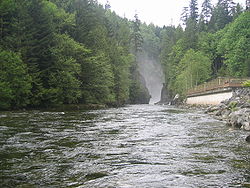
Back Capilano River CEB Capilano River German رودخانه کپیلانو Persian Capilano (fleuve) French Capilano (fiume) Italian Capilano River Swedish کیپیلانو دریا Urdu
| Capilano River | |
|---|---|
 Capilano River | |
| Location | |
| Country | Canada |
| Province | British Columbia |
| District | New Westminster Land District |
| Physical characteristics | |
| Source | Capilano Mountain |
| • location | North Shore Mountains |
| Mouth | Burrard Inlet |
• location | Lower Mainland |
• coordinates | 49°19′16″N 123°8′22″W / 49.32111°N 123.13944°W[1] |
• elevation | 0 m (0 ft)[2] |
The Capilano River flows from north to south through the Coast Mountains on the North Shore of the Burrard Inlet between British Columbia's district municipalities of West Vancouver and North Vancouver and empties into Burrard Inlet, opposite Stanley Park. The river is one of three primary sources of drinking water for residents of Greater Vancouver, and flows through the Capilano watershed. The Cleveland Dam, built in 1954, impounds a reservoir for this purpose. The entire area of the reservoir and watershed area upstream of the dam is closed to the public to ensure the quality of the drinking water. Prior to construction of the Cleveland Dam, the Capilano River deposited large amounts of sediment into Burrard Inlet. A dredge was needed to remove this sediment build-up in order to keep Burrard Inlet open for ship traffic.
The Capilano River forms the rough boundary between North Vancouver and West Vancouver.
The Capilano has a historic salmon run which was impacted by the dam construction. In 1971 the Capilano Fish hatchery was opened. It was built 1/2 kilometre (km) downstream of the dam to ensure the survival of the run. Beyond strengthening the salmon stocks from the aftermath of the dam, the hatchery’s work also introduced chinook to the system in an attempt to establish a self-sustaining run.
The river flows through coastal rainforest and, in its lower stretches, follows a granite canyon with walls in excess of 40 metres tall in places.
The Capilano flows during periods of snow melt and rainfall mainly and slows to a trickle at other times.
The origin of the name Capilano River is obscure. The name is thought to be an anglicized form of names that were Squamish and Musqueam. The last man known as Chief Capilano died in 1870.[3]: 38
- ^ "Capilano River". BC Geographical Names.
- ^ Elevation derived from ASTER Global Digital Elevation Model, using GeoLocator, BCGNIS coordinates, and topographic maps.
- ^ Akrigg, G.P.V.; Akrigg, Helen B. (1986), British Columbia Place Names (3rd, 1997 ed.), Vancouver: UBC Press, ISBN 0-7748-0636-2
